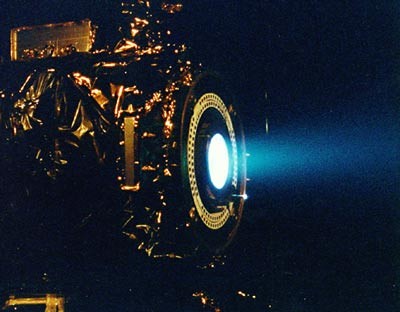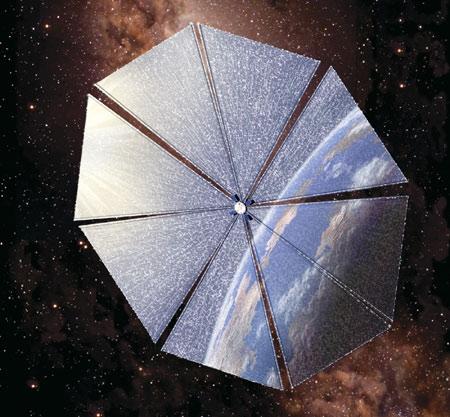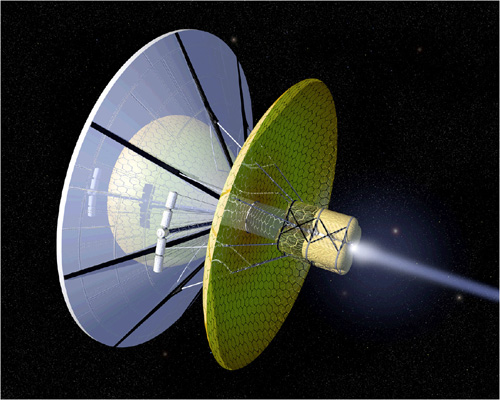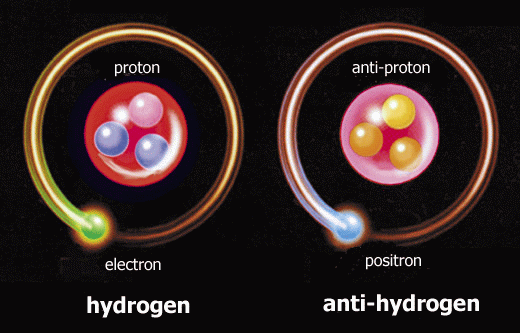

The closest method of propulsion in our future to replace conventional chemical rockets is most likely going to be the ion engine or the plasma engine, both of which run on essentially the same principle. Ion thrusters are an extremely weak, but extremely efficient form of propulsion. They work by using beams of electrically charged atoms or molecules (ions) to create thrust. There are two main forms of ion thrusters that fall under the categories of either electrostatic or electromagnetic. The electrostatic thruster uses the Coulomb force to accelerate the ions in the direction of the electric field. The electromagnetic thrusters use the Lorentz force which is the force on a point charge due to electromagnetic fields in order to accelerate the ions. Methods of powering ion thrusters may include nuclear fission or solar power, though it is possible that other power systems might be applicable. The drawback of ion engines, like most future spacecraft concepts, is that they do not produce enough short term thrust in order to escape Earth's atmosphere. In fact, the thrust would be so insignificant, that a small ion thruster would not likely even move on the surface of the planet. This would require the construction of ion thruster propelled ships take place in space, or to be delivered to space by other methods of propulsion.
The following excerpt from renowned theoretical physicist Michio Kaku's book, "Physics of the Impossible" explains more about ion and plasma thrusters".
Physics of the Impossible Excerpt
Another idea for future travel that shows some promise is the solar sail. A spacecraft would be attached to a reflective solar sail such that photons and solar wind would be capable of moving the craft at potentially enormous velocities. One of the downsides to having a solar sail propelled spacecraft is of course getting it into space, so like the ion engine spacecraft, it would have to have other means of reaching orbit. Another downside to solar sails is that the sails would have to be colossal in size in order to collect enough photons to have any noticeable impact on its acceleration. An effective solar sail would have to be hundreds of miles across, which would require some significant feats of engineering to accomplish. More than likely, the craft would have to be assembled in orbit, or on the moon so that the cumbersome nature of the spacecraft would not be as influential. The benefits to having such a craft could be enormous however, as on paper, it could reach speeds of up to half the speed of light, and could therefore reach Alpha Centauri, the nearest star system, within about eight years. To help achieve this velocity, and in order to steer the ship, batteries of high powered lasers would be placed on the moon, such that they could accelerate the spacecraft by firing into the sails. In order to make a return trip though, it would require a second battery of lasers to be built at the destination, such that they could propel the ship back. Before this becomes a feasible option for space travel, construction in space will likely have to become a commonplace occurance, and a more efficient means of delivering objects from Earth's atmosphere will be required.

One thing that physicists often worry about when designing rockets is the ratio of energy provided by the mass of the fuel. The higher the ratio, the more efficient the spacecraft is. One solution, the solar sail ship would have an infinite ratio. Another infinitely efficient method of propulsion would be a ramjet fusion engine. The ramjet fusion spacecraft works by collecting hydrogen atoms as it goes through space, and then releases their energy through nuclear fusion, and thus could continue traveling indefinately. The advantages to such a craft are obvious. If a 1000 ton craft, with a scoop of diameter 160km was able to maintain a constant force that resulted in a constant acceleration of 1g, it would be able to reach 77% of the speed of light within a year. Since the travelers aboard such a ship would be experiencing a slower passage of time as they approach the speed of light, they would only age by about eleven years in the time that it takes them to travel 400 light-years to the Pleiades star cluster, and only 23 years to reach the Andromeda galaxy 2 million light-years away. Conceivably, a passenger on such a ship could reach the edges of the known universe within their lifetime, despite the fact that billions of years would have passed on Earth. The disadvantage of such a system, is that the necessary fusion technology does not yet exist, and like the solar sail, construction would have to occur in space due to the cumbersome nature of the hydrogen scoop.

An idea for propulsion has been to use a massive railgun in order to launch objects into space, as well as from space to other areas. The downsides to this method of propulsion is that it would only be able to launch unmanned probes, or ships with durable robotics in place of humans, because the acceleration of a railgun projectile in space would be on the order of 5000 times the acceleration of Earth's gravity. Such an acceleration would guarantee that any human passengers would practically be liquified by the force experienced. Unlike other theoretical methods of propulsion, the benefit of the railgun is an ability to launch objects at speeds necessary to escape Earth's atmosphere. At the very least, it could theoretically be used to send durable cargo into space.

One of the most efficient future methods of propulsion would involve using the most expensive substance on earth - antimatter. Antimatter is composed of particles that have the opposite charges of normal matter. All antimatter has identical properties to its normal matter counterpart, except the charges are reversed. An antimatter equivalent of an electron thus has a positive charge, and is called a positron. Similarly, an antimatter equivalent of a proton would have a negative charge. By combining these particles, scientists have even made antihydrogen. The usefulness of antimatter is based on the fact that When normal matter and antimatter contact eachother, the result is mutual annihilation, which causes a release of energy more efficient than any other fuel source, including nuclear fusion. For some perspective, 1 kg of antimatter reacting with 1 kg of matter would release approximately the same amount of energy as 43 megatons of TNT. For the perspective of space travel, only 4mg of positrons would provide enough energy to rocket to Mars within a few weeks. The major downside to using antimatter as fuel is the scarcity, and thus the cost. As of 2005, the cost of creating antimatter was approximately $100 quadrillion per gram. Luckily, as research has continued, the cost has dropped down to approximately $62.5 trillion per gram. The cost is expected to drop in increments, but probably remain far too expensive for practical use, and far too rare. To date, the total amount of antimatter made at CERN would only be enough to power a light bulb for a few minutes. It is likely that some small regions of antimatter exist in the universe, so it is more likely that fuel for antimatter spacecraft would be gathered in such areas, which one may note, will still require us to develop a suitable method of space travel in the meantime in order to reach said areas. Using antimatter propulsion unfortunately brings us right back to the beginning in the search for new propulsion methods.